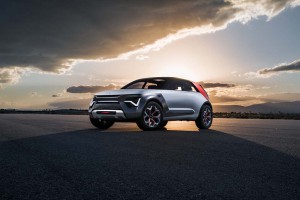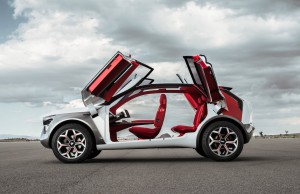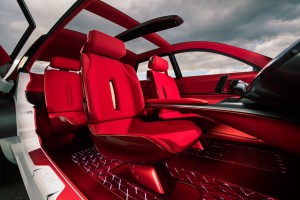
The Kia HabaNiro is an exercise showing where the automaker wants to take its electric vehicles in the future.
Kia is billing the appropriately named HabaNiro as a “spicy” take on its future EV strategy. Of course, the name offers a hint of where its going with the reference to Kia’s first long-range battery-electric vehicle, the Niro.
Like its sibling brand Hyundai, Kia has big plans to electrify during the coming decade, with a mix of hybrids, plug-ins, BEVs and even hydrogen fuel-cell vehicles. The HabaNiro, which was created at the Korean carmaker’s advanced design studio in California, is being billed as an “everything car,” or ECEV, and incorporates all sorts of creative design details and advanced technologies, including butterfly doors and Level 5 autonomous driving capabilities – as well as 300 miles of all-electric range.
“We imagined a car for everyone and nearly everything,” said Tom Kearns, vice president of design for Kia Design Center America. “Then, when we saw the finished product, we were blown away by the imagination of the HabaNiro’s creators and its laboratory of technology and we want it in our driveways. Today.”
A close look reveals a number of Niro details in the HabaNiro, but the concept has a longer, sleeker appearance, enhanced by its 20-inch wheels, short overhangs and the lightning bolt-like design element that plunges off the front wheel wells and stretches across the rocker panels. The look is completed by a “Lava Red” slash that angles downward from the roof and into the rear hatch.
(Kia uncovers two new SUV concepts at Seoul Motor Show. Click Here for the story.)

The Kia HabaNiro is designed to offer users maximum flexibility in their daily lives. The doors allow for unfettered access to the interior.
This really does seem to be the automotive equivalent of an everything bagel. Pretty much everywhere you look you’ll find something creative, intriguing or just plain odd. There are satin aluminum skid plates and tow hooks, for example, that suggests the HabaNiro would be just as comfortable off-road as it would be cruising through Manhattan.
Then, a second – or third – inspection reveals the lack of sideview mirrors, Kia betting on the eventual regulatory approval of sideview cameras.
Of course, once you get past all the gimmickry, you start learning more about where the automaker sees its electrification program going.
The current production Niro is available in a number of different packages including hybrid, plug-in and long-range all-electric.
The HabaNiro is the latter, and it takes advantage of the different layout going to a pure electric drivetrain allows by moving batteries, motors and other key components under the floorboards. The wheels, for example, are pushed all the way out to the corners.
That approach also allows for a much bigger cabin than the concept’s compact footprint would suggest.
(Click Here for a review of the new Kia Telluride.)

The interior of the HabaNiro is a fantasy wonderland. As for those suggesting it'll never be built, officials advise "don't bet the farm" against it.
The interior, meanwhile, is a fantasy land of high-technology systems, starting with a head-up display, or HUD, that runs the full width of the windshield. It’s controlled, according to a Kia statement, “by a concave acrylic instrument panel that is a large interactive touchpad display with Sensory Light Feedback (SLF). Technical Option Sharing System (TOSS) allows users to swipe and move vehicle options across the HUD screen as though moving chess pieces.”
As for HabaNiro’s self-driving system, it goes all the way to Level 5, meaning it would be capable of operating without a driver under all road and weather conditions. When in hands-free mode, the steering wheel and instrument panel retract, creating more space for passengers. Meanwhile, the HUD transforms into an in-vehicle entertainment system.
Then there’s the Real-Time Emotion Adaptive Driving, or READ, system, which “can optimize and personalize a vehicle cabin space by analyzing a driver’s emotional state in real-time through artificial intelligence-based bio-signal recognition technology. The technology monitors the driver’s emotional state and tailors the interior environment according to its assessment – potentially altering conditions relating to the human senses within the cabin and in turn creating a more pleasurable and safer driving experience.”
Considering the kitchen-sink approach the Kia design and engineering team took to develop the HabaNiro, it might be tempting to write the concept off as little more than a fantasy in chrome.
“Some will assume the HabaNiro concept will never be built,” the automaker said, “but we don’t advise betting the farm on it.”
(To see more about Kia’s latest Niro model: the EV, Click Here.)
While we’d be willing to bet our retirement fund that the show car won’t appear as shown on the New York Auto Show stage, there’s a very good chance HabaNiro is being used as a teaser to hint at a somewhat less spicy production battery-electric vehicle that could make it into production early in the coming decade.
